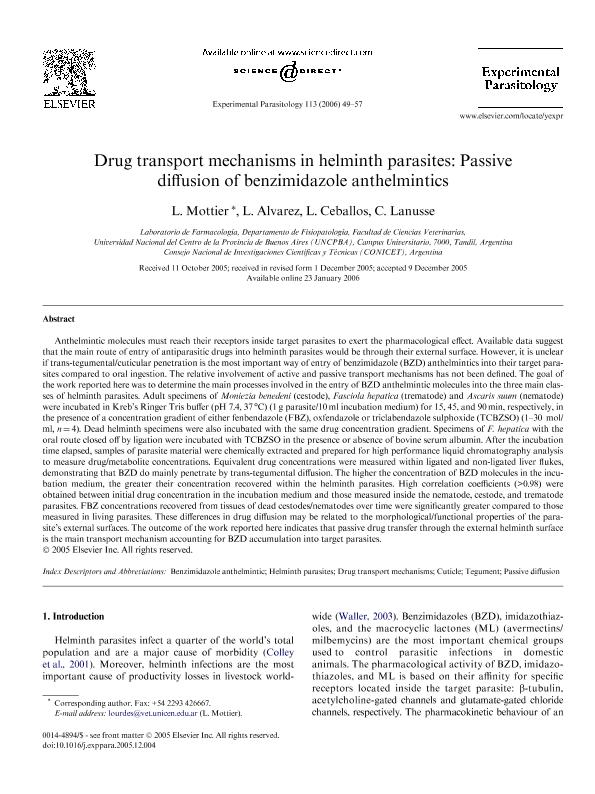Artículo
Drug transport mechanisms in helminth parasites: Passive diffusion of benzimidazole anthelmintics
Fecha de publicación:
05/2006
Editorial:
Academic Press Inc Elsevier Science
Revista:
Experimental Parasitology
ISSN:
0014-4894
e-ISSN:
1090-2449
Idioma:
Inglés
Tipo de recurso:
Artículo publicado
Clasificación temática:
Resumen
Anthelmintic molecules must reach their receptors inside target parasites to exert the pharmacological eVect. Available data suggest that the main route of entry of antiparasitic drugs into helminth parasites would be through their external surface. However, it is unclear if trans-tegumental/cuticular penetration is the most important way of entry of benzimidazole (BZD) anthelmintics into their target parasites compared to oral ingestion. The relative involvement of active and passive transport mechanisms has not been deWned. The goal of the work reported here was to determine the main processes involved in the entry of BZD anthelmintic molecules into the three main classes of helminth parasites. Adult specimens of Moniezia benedeni (cestode), Fasciola hepatica (trematode) and Ascaris suum (nematode) were incubated in Kreb’s Ringer Tris buVer (pH 7.4, 37 °C) (1 g parasite/10ml incubation medium) for 15, 45, and 90min, respectively, in the presence of a concentration gradient of either fenbendazole (FBZ), oxfendazole or triclabendazole sulphoxide (TCBZSO) (1–30 mol/ ml, nD4). Dead helminth specimens were also incubated with the same drug concentration gradient. Specimens of F. hepatica with the oral route closed oV by ligation were incubated with TCBZSO in the presence or absence of bovine serum albumin. After the incubation time elapsed, samples of parasite material were chemically extracted and prepared for high performance liquid chromatography analysis to measure drug/metabolite concentrations. Equivalent drug concentrations were measured within ligated and non-ligated liver Xukes, demonstrating that BZD do mainly penetrate by trans-tegumental diVusion. The higher the concentration of BZD molecules in the incubation medium, the greater their concentration recovered within the helminth parasites. High correlation coeYcients (>0.98) were obtained between initial drug concentration in the incubation medium and those measured inside the nematode, cestode, and trematode parasites. FBZ concentrations recovered from tissues of dead cestodes/nematodes over time were signiWcantly greater compared to those measured in living parasites. These diVerences in drug diVusion may be related to the morphological/functional properties of the parasite’s external surfaces. The outcome of the work reported here indicates that passive drug transfer through the external helminth surface is the main transport mechanism accounting for BZD accumulation into target parasites.
Palabras clave:
BENZIMIDAZOLE ANTHELMINTS
,
HELMINTH PARASITES
,
DRUG TRANSPORT MECHANISMS
Archivos asociados
Licencia
Identificadores
Colecciones
Articulos(CCT - TANDIL)
Articulos de CTRO CIENTIFICO TECNOLOGICO CONICET - TANDIL
Articulos de CTRO CIENTIFICO TECNOLOGICO CONICET - TANDIL
Articulos(CIVETAN)
Articulos de CENTRO DE INVESTIGACION VETERINARIA DE TANDIL
Articulos de CENTRO DE INVESTIGACION VETERINARIA DE TANDIL
Citación
Mottier, Maria de Lourdes; Alvarez, Luis Ignacio; Ceballos, Laura; Lanusse, Carlos Edmundo; Drug transport mechanisms in helminth parasites: Passive diffusion of benzimidazole anthelmintics; Academic Press Inc Elsevier Science; Experimental Parasitology; 113; 1; 5-2006; 49-57
Compartir
Altmétricas




